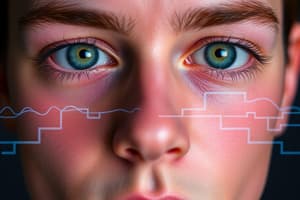Podcast
Questions and Answers
What is the primary structure that transmits sound waves to the cochlear fluid?
What is the primary structure that transmits sound waves to the cochlear fluid?
- Basilar membrane
- Inner hair cells
- Eardrum (correct)
- Outer hair cells
How does the basilar membrane respond to sound frequencies?
How does the basilar membrane respond to sound frequencies?
- Thinner sections respond more to lower frequencies
- Thicker sections vibrate more with higher frequencies
- It vibrates equally for all frequencies
- Different sections respond to different sound frequencies (correct)
What is the main difference in how rod cells and cone cells respond to weak light signals?
What is the main difference in how rod cells and cone cells respond to weak light signals?
- Rod cells require more light than cone cells for activation.
- Weak signals are combined in rod cells, while cone cells keep signals separate. (correct)
- Cone cells have a higher sensitivity to light than rod cells.
- Rod cells are primarily located in the fovea, while cone cells are in the periphery.
What is the role of hair cells in the cochlea?
What is the role of hair cells in the cochlea?
Where are rod cells mainly located in the human retina?
Where are rod cells mainly located in the human retina?
What is the approximate number of inner hair cells in the human cochlea?
What is the approximate number of inner hair cells in the human cochlea?
How many types of cone cells are present in the human retina?
How many types of cone cells are present in the human retina?
Which output neuron activation pattern is observed for rod cells compared to cone cells?
Which output neuron activation pattern is observed for rod cells compared to cone cells?
What percentage of the outgoing neural connections are associated with inner hair cells?
What percentage of the outgoing neural connections are associated with inner hair cells?
What is primarily responsible for the detection of weak light signals in the human retina?
What is primarily responsible for the detection of weak light signals in the human retina?
What is the primary function of sensory receptors in relation to energy patterns?
What is the primary function of sensory receptors in relation to energy patterns?
What describes the relationship between sensation and perception?
What describes the relationship between sensation and perception?
What physiological response is often associated with emotional reactions that can also affect vision?
What physiological response is often associated with emotional reactions that can also affect vision?
How does a photoreceptor respond to light intensity?
How does a photoreceptor respond to light intensity?
What is the dark adaptation curve used to illustrate?
What is the dark adaptation curve used to illustrate?
What does the initial rapid decrease in sensitivity during dark adaptation indicate?
What does the initial rapid decrease in sensitivity during dark adaptation indicate?
What does psychophysics study primarily?
What does psychophysics study primarily?
The retina contains an array of photoreceptors that serve what main purpose?
The retina contains an array of photoreceptors that serve what main purpose?
What characterizes the nature of chemical senses compared to other sensory systems?
What characterizes the nature of chemical senses compared to other sensory systems?
How do receptor responses function in relation to our sensory experience?
How do receptor responses function in relation to our sensory experience?
What does indirect perception require according to the understanding of sensations?
What does indirect perception require according to the understanding of sensations?
Why has cognitive psychology primarily focused on vision as a sensory system?
Why has cognitive psychology primarily focused on vision as a sensory system?
What is the effect of visual and other sensory information on taste?
What is the effect of visual and other sensory information on taste?
What is the absolute threshold in psychophysics?
What is the absolute threshold in psychophysics?
What does Weber's Law state about the just noticeable difference (JND)?
What does Weber's Law state about the just noticeable difference (JND)?
How do rod cells respond to light according to the content?
How do rod cells respond to light according to the content?
What does the difference threshold (or just noticeable difference) refer to?
What does the difference threshold (or just noticeable difference) refer to?
According to the provided information, what role does intensity play in relation to the JND?
According to the provided information, what role does intensity play in relation to the JND?
What does the term 'k' represent in Weber's Law?
What does the term 'k' represent in Weber's Law?
What distinguishes cone cells from rod cells in terms of pattern detection?
What distinguishes cone cells from rod cells in terms of pattern detection?
What aspect of perception does psychophysics primarily explore?
What aspect of perception does psychophysics primarily explore?
Flashcards are hidden until you start studying
Study Notes
Sensing The World
- Sensation refers to the physiological responses produced by sensory receptors when exposed to energy patterns in the world.
- Sensory receptors are specialized cells that convert sensory information into neural signals.
- Despite the type of stimulation, a receptor will produce the same neural response.
- Sensation is a physiological response that measures pieces of the world, while perception is the interpretation and organization of this sensory information.
Understanding Psychophysics
- Psychophysics examines the connections between physical stimuli and the psychological experiences they produce.
- Studying sensations is crucial for understanding how we perceive the world.
- The human eye's pupil can dilate to allow more light into the eye, but it is an immediate and small adaptation to overall light adaptation.
Receptor Roles in Light Sensitivity
- Dark adaptation is the process of our eyes becoming more sensitive to light in low-light conditions.
- Dark adaptation exhibits two distinct phases, characterized by a rapid initial decrease followed by a slower decrease and then another rapid decrease after 5-8 minutes, suggesting two distinct processes.
- The eye's retina contains two types of photoreceptors: rod cells and cone cells.
Comparing Rod & Cone Cells
- Rod cells are more numerous, primarily located in the periphery of the retina, and are responsible for our vision in low-light conditions.
- Cone cells are concentrated in the fovea, the central part of the retina, and are essential for color vision and fine detail perception.
- Rod cells combine signals from multiple cells, requiring less light for activation.
- Cone cells maintain individual signals, requiring stronger light for activation.
- Rod cells detect patterns but produce the same neural response regardless of the light intensity.
- Cone cells detect smaller differences in patterns and structure because their signals remain separate.
- Our perceptual experiences are influenced by whether rods or cones are involved in the detection of stimuli.
Psychophysics and Stimulus Detection
- Psychophysics utilizes quantitative methods to explore the effects of stimuli on perception.
- The absolute threshold represents the minimum energy level required for detecting a stimulus.
- The difference threshold (JND) is the minimum change in stimulus intensity needed to distinguish two stimuli.
Weber's Law and Stimulus Intensity
- Weber's Law states that the JND is proportional to the intensity of the initial stimulus.
- This means that the ratio of a change in intensity to the initial intensity remains constant, regardless of the stimulus intensity.
- The relationship between physical stimuli and our perceived experience is systematic, but not a one-to-one correspondence.
The Cochlea and Auditory Perception
- The cochlea, located within the inner ear, is filled with fluid and responsible for converting sound waves into neural signals.
- Sound waves cause vibrations in the basilar membrane, a flexible membrane within the cochlea.
- The basilar membrane vibrates differently depending on the frequency of sound, with lower frequencies vibrating the base more and higher frequencies vibrating the tip more.
- Hair cells, located on the basilar membrane, are the auditory receptors, and their response to vibrations allows for the distinction between different frequencies.
Chemical Senses
- Chemical senses (smell and taste) are among the oldest senses evolutionarily, connected to older neural and behavioral systems related to survival, food, and nutrition.
- Chemical senses are more subjective than other senses and can be influenced by visual, textural, temperature, olfactory, and other sensory information.
The Complexity of Vision
- Vision has been a primary focus in cognitive psychology due to its importance as a primary source of information about the world.
- Despite the complexity of visual processing, our retinal image is inverted, composed of individual points, and different in various parts of the retina.
Transforming Sensations into Perception
- Receptor responses are discrete, momentary, and dependent on physiology, lacking intrinsic meaning.
- Perceptual experiences are wholistic, continuous, and meaningful, dependent on the world.
- To bridge the gap between meaningless sensations and meaningful experiences, the mind transforms sensations into perception.
- Reconstructing the world from our sensory experiences is essential for indirect perception.
Studying That Suits You
Use AI to generate personalized quizzes and flashcards to suit your learning preferences.



